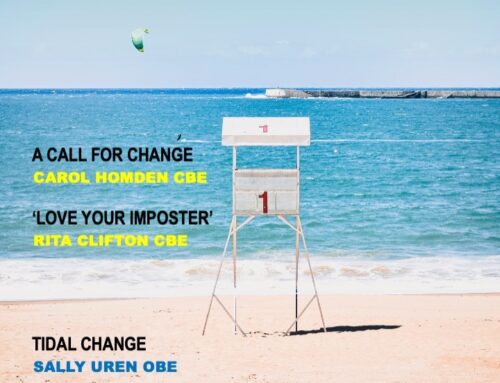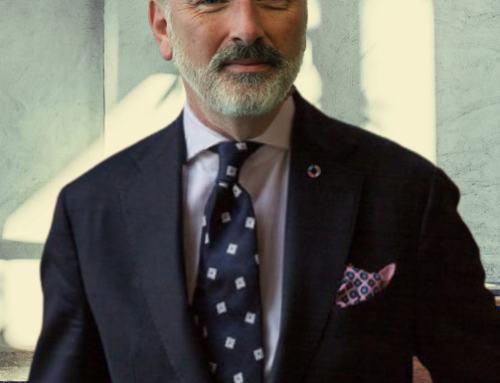Luxury’s Agents of Change

Luxury continued to assert its presence in Interbrand’s 20th Best Global Brands study, as the top performing industry for the second consecutive year. In the context of an industry that has outperformed other sectors, where businesses are based on the entire premise of excellence and leading the way, the luxury industry has an opportunity to take collective action to set transformational standards for its own businesses and beyond.
In the context of our times, the shift from the singularity of shareholder value to the collective value of wider stakeholders is far beyond something that we need to talk about, it’s a fundamental imperative of tangible action.
 One of the most compelling moves has been made by Prada. Known for their unique ability to both defy and define the evolution of luxury, the fashion house has recently committed to a ‘‘world-first’’ sustainability commitment, in the context of a term loan with Crédit Agricole Group, enabling the fashion house to favourably adjust its annual interest rates upon hitting specified sustainability goals. And it was the brand’s CFO who was notable by his voice on this announcement. This was evidence of a luxury brand proving its commitment to sustainability because it’s hardwired to their bottom line.
One of the most compelling moves has been made by Prada. Known for their unique ability to both defy and define the evolution of luxury, the fashion house has recently committed to a ‘‘world-first’’ sustainability commitment, in the context of a term loan with Crédit Agricole Group, enabling the fashion house to favourably adjust its annual interest rates upon hitting specified sustainability goals. And it was the brand’s CFO who was notable by his voice on this announcement. This was evidence of a luxury brand proving its commitment to sustainability because it’s hardwired to their bottom line.
This was a singularly bold move from a singularly bold brand. But what else can luxury brands do to extol their sustainable virtues? And how do they recast customer expectation in endlessly inventive new ways across ever more fluid generations and markets? Interbrand’s Best Global Brands report has analyzed this for 20 years and our 2019 data shows a continuation and an acceleration of this aptitude.
Legacy brands are pivoting from luxury as deeply exclusive, to more dynamically inclusive. New brands are emerging to define new categories and business models. And all in the restless pursuit of consumers who now ask to access luxury on their own terms. As we look at the brands which are demonstrating growth in luxury, they are the brands connecting the inside to the outside.
 Gucci has sustained its pivot through a hyper-focus on a culture of creativity and innovation, a commitment to talent and its Culture of Purpose, the brand’s ten-year sustainable-impact plan. At Dior, Creative Director Maria Grazia Chiuri has been clear that “fashion today should take on the responsibility of being an activist.” Having been the pioneers of bespoke, luxury brands are now digging deeper into reinventing it with new levels of relevance. The brands that are excelling are those who obsess about learning – and they are learning as much from their employees as from their customers.
Gucci has sustained its pivot through a hyper-focus on a culture of creativity and innovation, a commitment to talent and its Culture of Purpose, the brand’s ten-year sustainable-impact plan. At Dior, Creative Director Maria Grazia Chiuri has been clear that “fashion today should take on the responsibility of being an activist.” Having been the pioneers of bespoke, luxury brands are now digging deeper into reinventing it with new levels of relevance. The brands that are excelling are those who obsess about learning – and they are learning as much from their employees as from their customers.
The origins of leading luxury brands are inherently rooted in the restlessness of their founding pioneers. These are brands born out of a relentless quest to create something better, to do something better. To recall the inimitable words from Patek Philippe, “You never actually own a Patek Philippe, you merely look after it for future generations,” we should remember that luxury brands are some of the most sustainable in the world, because their products are built to last. Their craftsmanship is poised for the new economies of rental and resale, and their rarity is primed for long-term investment.
Enter the rise of re-commerce, as a prime learning example. Re-commerce is a rising new economy tapping into much of what is driving Millennial and Gen Z luxury consumption: from access, flexibility and on-demand aspiration, to clicking with a conscience. New paths to purchase have been opened up through the rise of ‘‘Generation RE,’’ by brands that saw the scale of the potential to define new categories in rental and resale. From Rent the Runway to The Real Real, re-commerce brands are tapping into evolving ways of living and consuming, where access, and ease of access, are everything. A new value exchange has emerged for luxury brands, where rental is opening up new levels of access and awareness, and resale is fuelled by the very brands that are creating product that’s built to last.
But when is too much access a tipping point for an industry that’s also driven by rarity and exclusivity? Luxury brands will have to navigate the balance of new levels of access (rental) and authenticity (resale), looking to deepen relevance of their iconic products, as well as looking to new forms of rarity and to more creative collaborations.
The calls to action raging across the world on change for good, at every level, are reaching further and deeper. Brands who are absent and silent in their actions on sustainability, on diversity and inclusion, are noticed – and will, increasingly, be called out. As Kering CEO, François-Henri Pinault states in the commitments to sustainability with the French government: “We have to work collectively. It’s about leaders who will put themselves in an uncomfortable situation to force themselves to move.”
So, what changes? And what does real change look like? When we reflect on the brands that we have tracked over two decades in our Best Global Brands study, luxury is not a category that they have “decided to be in.” Whether these brands have their origins in fashion, leather goods or hard luxury, they all arose from one fundamental purpose: to do something better, to create something better, to seek and set a standard in excellence.
As we look ahead 20 years, what will new disruptions in the industry look like? What if we could count on a commitment beyond an individual brand level, to a collective, collaborating on a united front to apply that pioneering DNA in the quest for better, to the greater good?
The time is now to set the agenda in excellence in solving problems in ways that are faster, more effective, and have greater impact than anyone else. There are big moves that we are all looking to, that we are holding business, ourselves and each other accountable to. The iconic move of the industry would be to collaborate around a deep and accelerated commitment to change for good, in everything from diversity and inclusion, to sustainability. In 20 years, let’s forecast a more powerful narrative on what these brands succeeded in changing for good. It’s time to call time on ourselves, as ever-more-conscious consumers, as we call time on brands to be more conscious creators.
Rebecca Robins
Global Chief Learning and Culture Officer, Interbrand
Twitter: @robins_rebecca
LinkedIn: Rebecca Robins

Luxury’s Agents of Change

Luxury continued to assert its presence in Interbrand’s 20th Best Global Brands study, as the top performing industry for the second consecutive year. In the context of an industry that has outperformed other sectors, where businesses are based on the entire premise of excellence and leading the way, the luxury industry has an opportunity to take collective action to set transformational standards for its own businesses and beyond.
In the context of our times, the shift from the singularity of shareholder value to the collective value of wider stakeholders is far beyond something that we need to talk about, it’s a fundamental imperative of tangible action.
 One of the most compelling moves has been made by Prada. Known for their unique ability to both defy and define the evolution of luxury, the fashion house has recently committed to a ‘‘world-first’’ sustainability commitment, in the context of a term loan with Crédit Agricole Group, enabling the fashion house to favourably adjust its annual interest rates upon hitting specified sustainability goals. And it was the brand’s CFO who was notable by his voice on this announcement. This was evidence of a luxury brand proving its commitment to sustainability because it’s hardwired to their bottom line.
One of the most compelling moves has been made by Prada. Known for their unique ability to both defy and define the evolution of luxury, the fashion house has recently committed to a ‘‘world-first’’ sustainability commitment, in the context of a term loan with Crédit Agricole Group, enabling the fashion house to favourably adjust its annual interest rates upon hitting specified sustainability goals. And it was the brand’s CFO who was notable by his voice on this announcement. This was evidence of a luxury brand proving its commitment to sustainability because it’s hardwired to their bottom line.
This was a singularly bold move from a singularly bold brand. But what else can luxury brands do to extol their sustainable virtues? And how do they recast customer expectation in endlessly inventive new ways across ever more fluid generations and markets? Interbrand’s Best Global Brands report has analyzed this for 20 years and our 2019 data shows a continuation and an acceleration of this aptitude.
Legacy brands are pivoting from luxury as deeply exclusive, to more dynamically inclusive. New brands are emerging to define new categories and business models. And all in the restless pursuit of consumers who now ask to access luxury on their own terms. As we look at the brands which are demonstrating growth in luxury, they are the brands connecting the inside to the outside.
 Gucci has sustained its pivot through a hyper-focus on a culture of creativity and innovation, a commitment to talent and its Culture of Purpose, the brand’s ten-year sustainable-impact plan. At Dior, Creative Director Maria Grazia Chiuri has been clear that “fashion today should take on the responsibility of being an activist.” Having been the pioneers of bespoke, luxury brands are now digging deeper into reinventing it with new levels of relevance. The brands that are excelling are those who obsess about learning – and they are learning as much from their employees as from their customers.
Gucci has sustained its pivot through a hyper-focus on a culture of creativity and innovation, a commitment to talent and its Culture of Purpose, the brand’s ten-year sustainable-impact plan. At Dior, Creative Director Maria Grazia Chiuri has been clear that “fashion today should take on the responsibility of being an activist.” Having been the pioneers of bespoke, luxury brands are now digging deeper into reinventing it with new levels of relevance. The brands that are excelling are those who obsess about learning – and they are learning as much from their employees as from their customers.
The origins of leading luxury brands are inherently rooted in the restlessness of their founding pioneers. These are brands born out of a relentless quest to create something better, to do something better. To recall the inimitable words from Patek Philippe, “You never actually own a Patek Philippe, you merely look after it for future generations,” we should remember that luxury brands are some of the most sustainable in the world, because their products are built to last. Their craftsmanship is poised for the new economies of rental and resale, and their rarity is primed for long-term investment.
Enter the rise of re-commerce, as a prime learning example. Re-commerce is a rising new economy tapping into much of what is driving Millennial and Gen Z luxury consumption: from access, flexibility and on-demand aspiration, to clicking with a conscience. New paths to purchase have been opened up through the rise of ‘‘Generation RE,’’ by brands that saw the scale of the potential to define new categories in rental and resale. From Rent the Runway to The Real Real, re-commerce brands are tapping into evolving ways of living and consuming, where access, and ease of access, are everything. A new value exchange has emerged for luxury brands, where rental is opening up new levels of access and awareness, and resale is fuelled by the very brands that are creating product that’s built to last.
But when is too much access a tipping point for an industry that’s also driven by rarity and exclusivity? Luxury brands will have to navigate the balance of new levels of access (rental) and authenticity (resale), looking to deepen relevance of their iconic products, as well as looking to new forms of rarity and to more creative collaborations.
The calls to action raging across the world on change for good, at every level, are reaching further and deeper. Brands who are absent and silent in their actions on sustainability, on diversity and inclusion, are noticed – and will, increasingly, be called out. As Kering CEO, François-Henri Pinault states in the commitments to sustainability with the French government: “We have to work collectively. It’s about leaders who will put themselves in an uncomfortable situation to force themselves to move.”
So, what changes? And what does real change look like? When we reflect on the brands that we have tracked over two decades in our Best Global Brands study, luxury is not a category that they have “decided to be in.” Whether these brands have their origins in fashion, leather goods or hard luxury, they all arose from one fundamental purpose: to do something better, to create something better, to seek and set a standard in excellence.
As we look ahead 20 years, what will new disruptions in the industry look like? What if we could count on a commitment beyond an individual brand level, to a collective, collaborating on a united front to apply that pioneering DNA in the quest for better, to the greater good?
The time is now to set the agenda in excellence in solving problems in ways that are faster, more effective, and have greater impact than anyone else. There are big moves that we are all looking to, that we are holding business, ourselves and each other accountable to. The iconic move of the industry would be to collaborate around a deep and accelerated commitment to change for good, in everything from diversity and inclusion, to sustainability. In 20 years, let’s forecast a more powerful narrative on what these brands succeeded in changing for good. It’s time to call time on ourselves, as ever-more-conscious consumers, as we call time on brands to be more conscious creators.
Rebecca Robins
Global Chief Learning and Culture Officer, Interbrand
Twitter: @robins_rebecca
LinkedIn: Rebecca Robins




